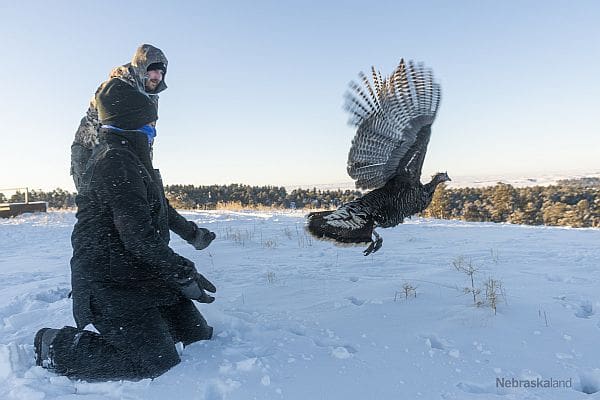Research Investigates Wild Turkey Nesting Survival in Agricultural Landscapes

EDGEFIELD, S.C.—Wild turkeys hold significant importance as a game species within the state of Nebraska; however, officials from state agencies, land managers and hunters have documented a decrease in the wild turkey population throughout the state. Photo credit: Nebraskaland Magazine, Nebraska Game and Parks Commission.
According to the Nebraska Game and Parks Commission, the state’s wild turkey population is estimated to have declined 45% from its peak 15 years ago. Current research from other states suggests that habitat loss coupled with predation are important factors affecting population declines. Consequently, habitat managers are focused on reducing potential interactions between nests and predators as a key strategy to address population declines.
In response to these observations, a new research endeavor will begin in winter 2023, investigating wild turkey survival and mortality as it relates to nest site selection in Nebraska.
In agricultural landscapes common to Nebraska, suitable nesting habitat is becoming patchy and more isolated. Historically, this has influenced the availability of suitable nesting cover for wild turkeys with the potential to affect nest survival. Previous research in another agricultural landscape suggested hens that chose nesting sites near forests and roads had greater probabilities of nest success than those that nested closer to agricultural fields.
This study aims to establish a connection between the occurrence and activity of potential nest predators (e.g., raccoons, opossums, coyotes) and the success of these nests. Additionally, researchers hope to better understand how the makeup of a landscape impacts potential predator activity at wild turkey nest sites. The objective is to enhance wild turkey productivity within agricultural-dominated landscapes common in Nebraska.
This research, led by Andrew Little, assistant professor at the University of Nebraska-Lincoln, will examine the differences in mammal predator activity in places where wild turkeys choose to make their nests compared to areas where turkeys avoid nesting.
“Our proposed work will develop a ‘mammal predator activity’ variable that will be used in turkey nest survival models and reveal if mammalian predators are more active in areas where turkeys nest and if predator activity is a key predictor in turkey nest success,” Little said.
Research conducted will measure the daily occurrence and activity of potential wild turkey nest predators across two NWTF areas of focus in western Nebraska. Additionally, researchers will evaluate human-made features (roads, structures, etc.) and land cover types that may influence these potential nest predators’ daily movement.
Study sites in each region will include Wildlife Management Areas, walk-in access lands and privately-owned lands.
Wild turkeys will be captured during winter (December-March, 2023-2025) using drop nets and walk-in traps and fitted with an aluminum leg band for identification. Researchers aim to fit 40 female wild turkeys with remotely downloadable backpack-style transmitters to record the birds’ location data.
Little and his team will then conduct camera surveys during the primary nesting period of wild turkeys on the study sites (April 1 to July 31). Using cameras will allow them to measure nest predator species’ distribution, quantity and activity within the two study regions.
The researchers will set up nearly 300 Bushnell Trophy game cameras to capture images of potential mammal predators that could harm the nests. These cameras will be put at a distance from the turkey nests to minimize abandonment and will not be visited until the end of the nesting season to avoid human pressure around nests. The research team will then review the images to determine how often nest predators are influencing nest sites.
“This project will also provide important information for the NWTF, wildlife managers and hunters to inform future habitat and predator management related efforts with the goal of improving nest survival,” Little said.
Additionally, the project has received $5,000 from the NWTF Nebraska State Chapter Super Fund to assist the project in disease monitoring.
This project is one of 10 new research projects across nine states the NWTF is funding, with $582,374 invested among these vital projects. These projects are part of a nearly $9 million investment into wild turkey research in 2023, supported by the NWTF and its partners.
About the National Wild Turkey Federation
Since 1973, the National Wild Turkey Federation has invested over half a billion dollars into wildlife conservation and has conserved or enhanced over 22 million acres of critical wildlife habitat. The organization continues to drive wildlife conservation, forest resiliency and robust recreational opportunities throughout the U.S. by working across boundaries on a landscape scale.
2023 is the NWTF’s 50th anniversary and an opportunity to propel the organization’s mission into the future while honoring its rich history. For its 50th anniversary, the NWTF has set six ambitious goals: positively impact 1 million acres of wildlife habitat; raise $500,000 for wild turkey research; increase membership to 250,000 members; dedicate $1 million to education and outreach programs; raise $5 million to invest in technology and NWTF’s people; and raise $5 million to build toward a $50 million endowment for the future. Learn how you can help us reach these lofty goals.
